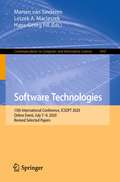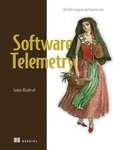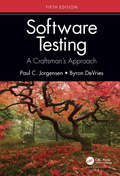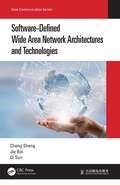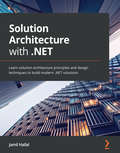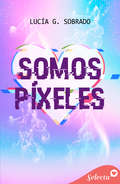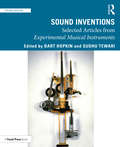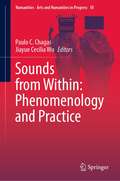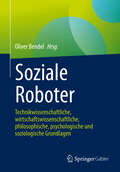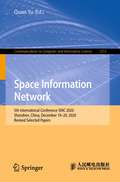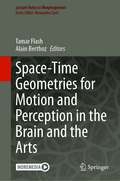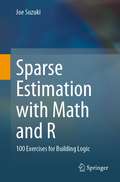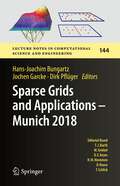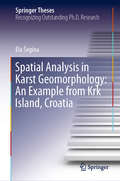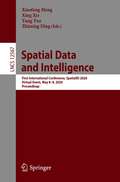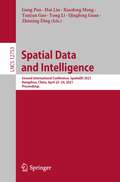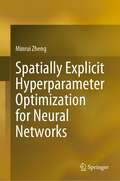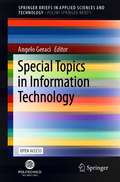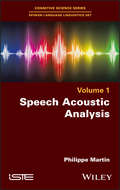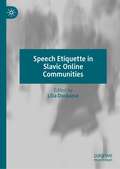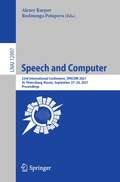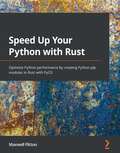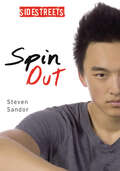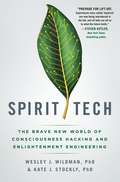- Table View
- List View
Software Technologies: 15th International Conference, ICSOFT 2020, Online Event, July 7–9, 2020, Revised Selected Papers (Communications in Computer and Information Science #1447)
by Marten Van Sinderen Leszek A. Maciaszek Hans-Georg FillThis book constitutes the thoroughly refereed proceedings of the 15th International Conference on Software Technologies, ICSOFT 2020, which was held virtually due to the Covid-19 pandemic. The 12 revised full papers were carefully reviewed and selected from 95 submissions. The papers deal with the following topics: business process modelling; IT service management; interoperability and service-oriented architecture; project management software; scheduling and estimating; software metrics; requirements elicitation and specification; software and systems integration among others.
Software Telemetry: Reliable logging and monitoring
by Jamie RiedeselSoftware Telemetry shows you how to efficiently collect, store, and analyze system and application log data so you can monitor and improve your systems. Summary In Software Telemetry you will learn how to: Manage toxic telemetry and confidential records Master multi-tenant techniques and transformation processes Update to improve the statistical validity of your metrics and dashboards Make software telemetry emissions easier to parse Build easily-auditable logging systems Prevent and handle accidental data leaks Maintain processes for legal compliance Justify increased spend on telemetry software Software Telemetry teaches you best practices for operating and updating telemetry systems. These vital systems trace, log, and monitor infrastructure by observing and analyzing the events generated by the system. This practical guide is filled with techniques you can apply to any size of organization, with troubleshooting techniques for every eventuality, and methods to ensure your compliance with standards like GDPR. About the technology Take advantage of the data generated by your IT infrastructure! Telemetry systems provide feedback on what&’s happening inside your data center and applications, so you can efficiently monitor, maintain, and audit them. This practical book guides you through instrumenting your systems, setting up centralized logging, doing distributed tracing, and other invaluable telemetry techniques. About the book Software Telemetry shows you how to efficiently collect, store, and analyze system and application log data so you can monitor and improve your systems. Manage the pillars of observability—logs, metrics, and traces—in an end-to-end telemetry system that integrates with your existing infrastructure. You&’ll discover how software telemetry benefits both small startups and legacy enterprises. And at a time when data audits are increasingly common, you&’ll appreciate the thorough coverage of legal compliance processes, so there&’s no reason to panic when a discovery request arrives. What's inside Multi-tenant techniques and transformation processes Toxic telemetry and confidential records Updates to improve the statistical validity of your metrics and dashboards Revisions that make software telemetry emissions easier to parse About the reader For software developers and infrastructure engineers supporting and building telemetry systems. About the author Jamie Riedesel is a staff engineer at Dropbox with over twenty years of experience in IT. Table of Contents 1 Introduction PART 1 TELEMETRY SYSTEM ARCHITECTURE 2 The Emitting stage: Creating and submitting telemetry 3 The Shipping stage: Moving and storing telemetry 4 The Shipping stage: Unifying diverse telemetry formats 5 The Presentation stage: Displaying telemetry 6 Marking up and enriching telemetry 7 Handling multitenancy PART 2 USE CASES REVISITED: APPLYING ARCHITECTURE CONCEPTS 8 Growing cloud-based startup 9 Nonsoftware business 10 Long-established business IT PART 3 TECHNIQUES FOR HANDLING TELEMETRY 11 Optimizing for regular expressions at scale 12 Standardized logging and event formats 13 Using more nonfile emitting techniques 14 Managing cardinality in telemetry 15 Ensuring telemetry integrity 16 Redacting and reprocessing telemetry 17 Building policies for telemetry retention and aggregation 18 Surviving legal processes
Software Testing: A Craftsman’s Approach, Fifth Edition
by Paul C. Jorgensen Byron DeVriesThis updated and reorganized Fifth edition of Software Testing: A Craftsman's Approach applies the strong mathematics content of previous editions to a coherent treatment of software testing. Responding to instructor and student survey input of previous editions, the authors have streamlined chapters and examples. The Fifth Edition: Has a new chapter on feature interaction testing that explores the feature interaction problem and explains how to reduce tests Uses Java instead of pseudo-code for all examples including structured and object-oriented ones Presents model-based development and provides an explanation of how to conduct testing within model-based development environments Explains testing in waterfall, iterative, and agile software development projects Explores test-driven development, reexamines all-pairs testing, and explains the four contexts of software testing Thoroughly revised and updated, Software Testing: A Craftsman’s Approach, Fifth Edition is sure to become a standard reference for those who need to stay up to date with evolving technologies in software testing. Carrying on the tradition of previous editions, it is a valuable reference for software testers, developers, and engineers.
Software-Defined Wide Area Network Architectures and Technologies (Data Communication Series)
by Cheng Sheng Jie Bai Qi SunStarting with problems and challenges faced by enterprise WANs, Software-Defined Wide Area Network Architectures and Technologies provides a detailed description of SD-WAN’s background and basic features, as well as the system architecture, operating mechanism, and application scenarios of the SD-WAN solution based on the implementation of Huawei SD-WAN Solution. It also explains key SD-WAN technologies and analyzes real SD-WAN deployment cases, affording readers with design methods and deployment suggestions for the SD-WAN solution. The information presented in this book is easy to understand and very practical. It enables you to become adept in the SD-WAN solution’s implementation and design principles. The book is intended for ICT practitioners, such as network technical support engineers, network administrators, and network planning engineers, to use in studying theory. Furthermore, it serves as reference material for network technology enthusiasts. Authors Cheng Sheng is the Chief Architect of Huawei’s SD-WAN Solution. He has nearly 20 years of experience in network product and solution design, as well as extensive expertise in product design and development, network planning and design, and network engineering project implementation. Jie Bai is an Architect of Huawei’s SD-WAN Solution. He is well versed in Huawei security products and SD-WAN Solution and has written books such as Huawei Firewall Technology Talk as well as Huawei Anti-DDoS Technology Talk. Qi Sun is a Senior Information Architect of Huawei, and he is knowledgeable in Huawei SD-WAN Solution, CloudVPN Solution, and Cloud Management Solution. He also participated in the information architecture design and delivery of multiple solutions.
Solution Architecture with .NET: Learn solution architecture principles and design techniques to build modern .NET solutions
by Jamil HallalLearn about the responsibilities of a .NET solution architect and explore solution architecture principles, DevOps solutions, and design techniques and standards with hands-on examples of design patternsKey FeaturesFind out what are the essential personality traits and responsibilities of a solution architectBecome well-versed with architecture principles and modern design patterns with hands-on examplesDesign modern web solutions and make the most of Azure DevOps to automate your development life cycleBook DescriptionUnderstanding solution architecture is a must to build and integrate robust systems to meet your client's needs. This makes it crucial for a professional .NET software engineer to learn the key skills of a .NET solution architect to create a unique digital journey and build solutions for a wide range of industries, from strategy and design to implementation. With this handbook, developers working with the .NET technology will be able to put their knowledge to work.The book takes a hands-on approach to help you become an effective solution architect. You'll start by learning the principles of the software development life cycle (SDLC), the roles and responsibilities of a .NET solution architect, and what makes a great .NET solution architect. As you make progress through the chapters, you'll understand the principles of solution architecture and how to design a solution, and explore designing layers and microservices. You'll complete your learning journey by uncovering modern design patterns and techniques for designing and building digital solutions.By the end of this book, you'll have learned how to architect your modern web solutions with ASP.NET Core and Microsoft Azure and be ready to automate your development life cycle with Azure DevOps.What you will learnUnderstand the role and core responsibilities of a .NET solution architectStudy popular UML (Unified Modeling Language) diagrams for solution architectureWork with modern design patterns with the help of hands-on examplesBecome familiar with microservices and designing layersDiscover how to design modern web solutionsAutomate your development life cycle with Azure DevOpsWho this book is forThis book is for intermediate and advanced .NET developers and software engineers who want to advance their careers and expand their knowledge of solution architecture and design principles. Beginner or intermediate-level solution architects looking for tips and tricks to build large-scale .NET solutions will find this book useful.
Somos píxeles
by Lucía G. Sobrado«Atron. Su oasis en medio del desierto. Atron. Su lugar de evasión. Atron. El videojuego que marcó su adolescencia.» A ojos del mundo, la vida de Myriam es maravillosa: se lleva bien con su familia, le encanta el ballet, que lleva practicando desde niña, y tiene un novio perfecto, Mario. Pero las apariencias engañan y, desde hace años, Myriam no se siente ella misma, específicamente desde que su videojuego favorito, Atron, desapareció del mapa... y con él, sus mejores amigos. Por eso, cuando lee la noticia de que Atron vuelve, mejorado y dispuesto a revolucionar el mundo virtual, le da un vuelco el corazón. Tiene la oportunidad de reencontrarse con su hobby y sus amigos, en especial con Kinan, y no planea desperdiciarla. Pero a medida que Myriam se va recuperando más y más así misma, más se da cuenta de que, igual, su relación con Mario no es tan maravillosa como creía. Y que es posible que, durante toda su vida, haya pensado en Kinan como su mejor amiga, cuando en realidad podría haber algo más entre ellas... Cuando tu vida virtual supera la realidad, ¿te la jugarías por ganar la partida?
Sound Inventions: Selected Articles from Experimental Musical Instruments (Sound Design)
by Bart Hopkin Sudhu TewariSound Inventions is a collection of 34 articles taken from Experimental Musical Instruments, the seminal journal published from 1984 through 1999. In addition to the selected articles, the editors have contributed introductory essays, placing the material in cultural and temporal context, providing an overview of the field both before and after the time of original publication. The Experimental Musical Instruments journal contributed extensively to a number of sub-fields, including sound sculpture and sound art, sound design, tuning theory, musical instrument acoustics, timbre and timbral perception, musical instrument construction and materials, pedagogy, and contemporary performance and composition. This book provides a picture of this important early period, presenting a wealth of material that is as valuable and relevant today as it was when first published, making it essential reading for anyone researching, working with or studying sound.
Sounds from Within: Phenomenology and Practice (Numanities - Arts and Humanities in Progress #18)
by Paulo C. Chagas Jiayue Cecilia WuThis book transforms phenomenology, music, technology, and the cultural arts from within. Gathering contributions by performing artists, media technology designers, nomadic composers, and distinguished musicological scholars, it explores a rich array of concepts such as embodiment, art and technology, mindfulness meditation, time and space in music, self and emptiness, as well as cultural heritage preservation. It does so via close studies on music phenomenology theory, works involving experimental music and technology, and related cultural and historical issues. This book will be of considerable interest to readers from the fields of sound studies, science and technology studies, phenomenology, cultural studies, media studies, and sound art theory. This book is equally relevant and insightful for musicians, composers, media artists, sound artists, technology designers, and curators and arts administrators from the performing and visual arts.
Sovereignty Blockchain 1.0: Orderly Internet and Community with a Shared Future for Humanity
by Lian YumingThis book presents a general framework analysis of sovereignty in blockchain based on the concept of blockchain technology, and specifically discusses the three theoretical foundations of sovereignty in blockchain: data sovereignty theory, social trust theory, and smart contract theory. It also explores the evolution of laws concerning data and digital rights, how to build trust mechanisms for digital rights transactions, as well as contract signing and the implementation of digital rights transactions.
Soziale Roboter: Technikwissenschaftliche, wirtschaftswissenschaftliche, philosophische, psychologische und soziologische Grundlagen
by Oliver BendelSoziale Roboter sind sensomotorische Maschinen, die für den Umgang mit Menschen oder Tieren geschaffen wurden. Sie können über fünf Dimensionen bestimmt werden, nämlich die Interaktion mit Lebewesen, die Kommunikation mit Lebewesen, die Nähe zu Lebewesen, die Abbildung von (Aspekten von) Lebewesen sowie – im Zentrum – den Nutzen für Lebewesen. Bei einem weiten Begriff können neben Hardwarerobotern auch Softwareroboter wie gewisse Chatbots, Voicebots und Social Bots dazu zählen. Die Disziplin, die soziale Roboter – ob als Spielzeugroboter, als Serviceroboter (Pflegeroboter, Therapieroboter, Sexroboter, Sicherheitsroboter etc.) oder als Industrieroboter in der Art von Kooperations- und Kollaborationsrobotern (Co-Robots bzw. Cobots) – erforscht und hervorbringt, ist die Soziale Robotik. Das Buch schafft Grundlagen in technikwissenschaftlicher, wirtschaftswissenschaftlicher, philosophischer, psychologischer und soziologischer Hinsicht. Es stellt dar, was soziale Roboter ausmacht, wie sie gebaut und programmiert werden, welche Anwendungsmöglichkeiten existieren und welche Herausforderungen sich ergeben.Das Kapitel 2 wird auf link.springer.com unter der Creative Commons Namensnennung 4.0 International Lizenz veröffentlicht.
Space Information Network: 5th International Conference SINC 2020, Shenzhen, China, December 19–20, 2020, Revised Selected Papers (Communications in Computer and Information Science #1353)
by Quan YuThis book constitutes selected and revised papers of the 5th International Conference on Space Information Networks, SINC 2020, held in Shenzhen, China, in December 2020.The 11 full and 2 short papers presented in this volume were carefully reviewed and selected from 104 submissions. The papers present the latest research in the fields of space information networks.
Space-Time Geometries for Motion and Perception in the Brain and the Arts (Lecture Notes in Morphogenesis)
by Alain Berthoz Tamar FlashThis book is based on a two-day symposium at the Paris Institute of Advanced Study titled "space-time geometries and movement in the brain and the arts". It includes over 20 chapters written by the leading scientists and artists who presented their related research studies at the symposium and includes six sections; the first three focus on space-time geometries in perception, action and memory while the last three focus on specific artistic domains: drawing and painting, dance, music, digital arts and robotics. The book is accompanied by a dedicated webpage including related images and videos. There is an ever-growing interest in the topics covered by this book. Space and time are of fundamental importance for our understanding of human perception, action, memory and cognition, and are entities which are equally important in physics, biology, neuroscience and psychology. Highly prominent scientists and mathematicians have expressed their belief that our bodies and minds shape the ways we perceive space and time and the physical laws we formulate. Understanding how the brain perceives motion and generates -bodily movements is of great significance. There is also growing interest in studying how space, time and movement subserve artistic creations in different artistic modalities (e.g., fine arts, digital and performing arts and music). This interest is inspired by the idea that artists make intuitive use of the principles and simplifying strategies used by the brain in movement generation and perception. Building upon new understanding of the spatio-temporal geometries subserving movement generation and perception by the brain we can start exploring how artists make use of such neuro --geometrical and neuro-dynamic representations in order to express artistic concepts and emotionally affect the human observers and listeners. Scientists have also started formulating new ideas of how aesthetic judgements emerge from the principles and brain mechanisms subserving motor control and motion perception.Covering novel and multidisciplinary topics, this advanced book will be of interest to neuroscientists, behavioral scientists, artificial intelligence and robotics experts, students and artists.
Sparse Estimation with Math and R: 100 Exercises for Building Logic
by Joe SuzukiThe most crucial ability for machine learning and data science is mathematical logic for grasping their essence rather than knowledge and experience. This textbook approaches the essence of sparse estimation by considering math problems and building R programs. Each chapter introduces the notion of sparsity and provides procedures followed by mathematical derivations and source programs with examples of execution. To maximize readers’ insights into sparsity, mathematical proofs are presented for almost all propositions, and programs are described without depending on any packages. The book is carefully organized to provide the solutions to the exercises in each chapter so that readers can solve the total of 100 exercises by simply following the contents of each chapter.This textbook is suitable for an undergraduate or graduate course consisting of about 15 lectures (90 mins each). Written in an easy-to-follow and self-contained style, this book will also be perfect material for independent learning by data scientists, machine learning engineers, and researchers interested in linear regression, generalized linear lasso, group lasso, fused lasso, graphical models, matrix decomposition, and multivariate analysis.This book is one of a series of textbooks in machine learning by the same author. Other titles are: - Statistical Learning with Math and R (https://www.springer.com/gp/book/9789811575679) - Statistical Learning with Math and Python (https://www.springer.com/gp/book/9789811578762) - Sparse Estimation with Math and Python
Sparse Grids and Applications - Munich 2018 (Lecture Notes in Computational Science and Engineering #144)
by Hans-Joachim Bungartz Dirk Pflüger Jochen GarckeSparse grids are a popular tool for the numerical treatment of high-dimensional problems. Where classical numerical discretization schemes fail in more than three or four dimensions, sparse grids, in their different flavors, are frequently the method of choice.This volume of LNCSE presents selected papers from the proceedings of the fifth workshop on sparse grids and applications, and demonstrates once again the importance of this numerical discretization scheme. The articles present recent advances in the numerical analysis of sparse grids in connection with a range of applications including uncertainty quantification, plasma physics simulations, and computational chemistry, to name but a few.
Spatial Analysis in Karst Geomorphology: An Example from Krk Island, Croatia (Springer Theses)
by Ela ŠeginaThis book presents (i) a comprehensive methodological approach in analyzing karst surface features using contemporary GIS tools of high resolution applied on a large study area and extensive dataset, (ii) a revision and evaluation of the existing concepts valid in the modern karst geomorphology, (iii) a detailed elaboration of overlooked and yet undefined karst surface features, and (iv) an innovation in the discussion on origin and evolution of karst surface features. The book contains the first example of such comprehensive application of the modern technologies in spatial analysis in the field of karst geomorphology, and it offers several new methodological and theoretical perspectives and presents numerous starting points for further research. It contributes both to the understanding of the local karst evolution and to the knowledge of karst surface features globally.
Spatial Data and Intelligence: First International Conference, SpatialDI 2020, Virtual Event, May 8–9, 2020, Proceedings (Lecture Notes in Computer Science #12567)
by Xiaofeng Meng Zhiming Ding Xing Xie Yang YueThis book constitutes the proceedings of the First International Conference on Spatial Data and Intelligence, SpatialDI 2020, which was held on May 8-9, 2020. The conference was planned to take place in Shenzhen, China, and changed to an online format due to the COVID-19 pandemic. The 21 full papers presented in this volume were carefully reviewed and selected from 50 submissions. They were organized in topical sections named: traffic management; data science; and visualization science.
Spatial Data and Intelligence: Second International Conference, SpatialDI 2021, Hangzhou, China, April 22–24, 2021, Proceedings (Lecture Notes in Computer Science #12753)
by Gang Pan Xiaofeng Meng Zhiming Ding Yong Li Yunjun Gao Hui Lin Qingfeng GuanThis book constitutes the proceedings of the Second International Conference on Spatial Data and Intelligence, SpatialDI 2021, which was held during April 22-24, 2021 in Hangzhou, China.The 14 full papers and 7 short papers presented in this volume were carefully reviewed and selected from 72 submissions. They are organized in the topical sections named: traffic management, data science, and city analysis.
Spatially Explicit Hyperparameter Optimization for Neural Networks
by Minrui ZhengNeural networks as the commonly used machine learning algorithms, such as artificial neural networks (ANNs) and convolutional neural networks (CNNs), have been extensively used in the GIScience domain to explore the nonlinear and complex geographic phenomena. However, there are a few studies that investigate the parameter settings of neural networks in GIScience. Moreover, the model performance of neural networks often depends on the parameter setting for a given dataset. Meanwhile, adjusting the parameter configuration of neural networks will increase the overall running time. Therefore, an automated approach is necessary for addressing these limitations in current studies. This book proposes an automated spatially explicit hyperparameter optimization approach to identify optimal or near-optimal parameter settings for neural networks in the GIScience field. Also, the approach improves the computing performance at both model and computing levels. This book is written for researchers of the GIScience field as well as social science subjects.
Special Topics in Information Technology (SpringerBriefs in Applied Sciences and Technology)
by Angelo GeraciThis open access book presents thirteen outstanding doctoral dissertations in Information Technology from the Department of Electronics, Information and Bioengineering, Politecnico di Milano, Italy. Information Technology has always been highly interdisciplinary, as many aspects have to be considered in IT systems. The doctoral studies program in IT at Politecnico di Milano emphasizes this interdisciplinary nature, which is becoming more and more important in recent technological advances, in collaborative projects, and in the education of young researchers. Accordingly, the focus of advanced research is on pursuing a rigorous approach to specific research topics starting from a broad background in various areas of Information Technology, especially Computer Science and Engineering, Electronics, Systems and Control, and Telecommunications. Each year, more than 50 PhDs graduate from the program. This book gathers the outcomes of the thirteen best theses defended in 2019-20 and selected for the IT PhD Award. Each of the authors provides a chapter summarizing his/her findings, including an introduction, description of methods, main achievements and future work on the topic. Hence, the book provides a cutting-edge overview of the latest research trends in Information Technology at Politecnico di Milano, presented in an easy-to-read format that will also appeal to non-specialists.
Speech Acoustic Analysis
by Philippe MartinThe text sets out in simple and accessible terms the various methods of acoustic analysis of speech, placing them in their historical context, allowing a better understanding of the mathematical and technical solutions adopted today in phonetics and experimental phonology. Without mathematical complications, the operating bases of the many speech analysis software currently available are exposed so that everyone can understand the limits and avoid errors and misinterpretations in their implementation.
Speech Etiquette in Slavic Online Communities
by Lilia DuskaevaThis edited book focuses on speech etiquette, examining the rules that govern communication in various online communities: professional, female, and ethnospecific. The contributors analyze online communication in the Slavic languages Russian, Slovak, Polish, and Belarusian, showing how the concept of speech etiquette differs from the concept of politeness, although both reflect the relationship between people in interaction. Online communities are united on the basis of common informative or phatic illocutions among their participants, and their speech etiquette is manifested in stable forms of conducting discussions – stimulating and responding. Each group has its own ideas of unacceptable speech behavior and approaches to sanitation, and the rules of speech etiquette in each group determine the degree of rapport and distancing between the participants in discourse. The chapters in this book explore how rapport and distance are established through acts such as showing attention to the addressee and increasing his or her communicative status; reducing or increasing the illocutionary power of evaluations and motivations; and evaluating one’s own or someone else’s speech. The volume will be of interest to researchers studying online communication in such diverse fields as linguistics, sociology, anthropology, programming, and media studies.
Speech and Computer: 23rd International Conference, SPECOM 2021, St. Petersburg, Russia, September 27–30, 2021, Proceedings (Lecture Notes in Computer Science #12997)
by Rodmonga Potapova Alexey KarpovThis book constitutes the proceedings of the 23rd International Conference on Speech and Computer, SPECOM 2021, held in St. Petersburg, Russia, in September 2021.* The 74 papers presented were carefully reviewed and selected from 163 submissions. The papers present current research in the area of computer speech processing including audio signal processing, automatic speech recognition, speaker recognition, computational paralinguistics, speech synthesis, sign language and multimodal processing, and speech and language resources.*Due to the COVID-19 pandemic, SPECOM 2021 was held as a hybrid event.
Speed Up Your Python with Rust: Optimize Python performance by creating Python pip modules in Rust with PyO3
by Maxwell FlittonDiscover how to inject your code with highly performant Rust features to develop fast and memory-safe applicationsKey FeaturesLearn to implement Rust in a Python system without altering the entire systemWrite safe and efficient Rust code as a Python developer by understanding the essential features of RustBuild Python extensions in Rust by using Python NumPy modules in your Rust codeBook DescriptionPython has made software development easier, but it falls short in several areas including memory management that lead to poor performance and security. Rust, on the other hand, provides memory safety without using a garbage collector, which means that with its low memory footprint, you can build high-performant and secure apps relatively easily. However, rewriting everything in Rust can be expensive and risky as there might not be package support in Rust for the problem being solved. This is where Python bindings and pip come in.This book will help you, as a Python developer, to start using Rust in your Python projects without having to manage a separate Rust server or application. Seeing as you'll already understand concepts like functions and loops, this book covers the quirks of Rust such as memory management to code Rust in a productive and structured manner. You'll explore the PyO3 crate to fuse Rust code with Python, learn how to package your fused Rust code in a pip package, and then deploy a Python Flask application in Docker that uses a private Rust pip module. Finally, you'll get to grips with advanced Rust binding topics such as inspecting Python objects and modules in Rust.By the end of this Rust book, you'll be able to develop safe and high-performant applications with better concurrency support.What you will learnExplore the quirks of the Rust programming language that a Python developer needs to understand to code in RustUnderstand the trade-offs for multiprocessing and thread safety to write concurrent codeBuild and manage a software project with cargo and cratesFuse Rust code with Python so that Python can import and run Rust codeDeploy a Python Flask application in Docker that utilizes a private Rust pip moduleInspect and create your own Python objects in RustWho this book is forThis book is for Python developers who want to speed up their Python code with Rust and implement Rust in a Python system without altering the entire system. You'll be able to learn about all topics relating to Rust programming. Basic knowledge of Python is required to get the most out of this book.
Spin Out (Lorimer SideStreets)
by Steven SandorBen Cheng used to live the good life—he had wealthy parents, lots of friends, and respect as an online gamer. But when his parents separate, Ben's life changes entirely. He moves to a small apartment with his mom, his dad is out of the picture, and his new schoolmates start teasing him for his family's fall from grace. All Ben has left is his virtual life, where he still reigns supreme as an online racing driver. But when Ben takes his mom's car out for a joyride and gets caught, and uses his mom's credit card without permission, his life starts to spin out. Distributed in the U.S by Lerner Publishing Group
Spirit Tech: The Brave New World of Consciousness Hacking and Enlightenment Engineering
by Wesley J. Wildman Kate J. StocklyFeaturing a Foreword by Mikey Siegel, founder of Consciousness Hacking. Technology can now control the spiritual experience. This is a journey through the high-tech aids for psychological growth that are changing our world, while exploring the safety, authenticity and ethics of this new world.We already rely on technology to manage our health, sleep, relationships, and finances, so it’s no surprise that we’re turning to technological aids for the spiritual journey. From apps that help us pray or meditate, to cybernauts seeking the fast track to nirvana through magnetic brain stimulation, we are on the brink of the most transformative revolution in the practice of religion: an era in which we harness the power of “spirit tech” to deepen our experience of the divine.Spirit tech products are rapidly improving in sophistication and power, and ordinary people need a trustworthy guide. Through their own research and insiders’ access to the top innovators and early adopters, Wesley J. Wildman and Kate J. Stockly take you deep inside an evolving world:- Find out how increasingly popular “wearables” work on your brain, promising a shortcut to transformative meditative states.- Meet the inventor of the “God Helmet” who developed a tool to increase psychic skills, and overcome fear, sadness, and anger.- Visit churches that use ayahuasca as their sacrament and explore the booming industry of psychedelic tourism.- Journey to a mansion in the heart of Silicon Valley where a group of scientists and entrepreneurs are working feverishly to bring brain-based spirit tech applications to the masses.- Discover a research team who achieved brain-to-brain communication between individuals thousands of miles apart, harnessing neurofeedback techniques to sync and share emotions among group members.Spirit Tech offers readers a compelling glimpse into the future and is the definitive guide to the fascinating world of new innovations for personal transformation, spiritual growth, and pushing the boundaries of human nature.
